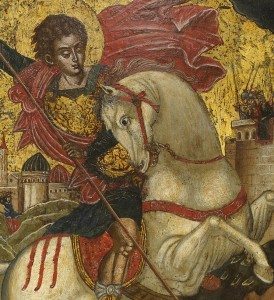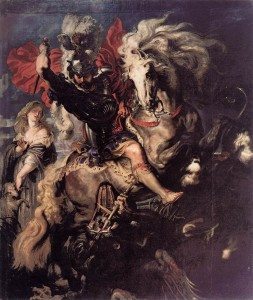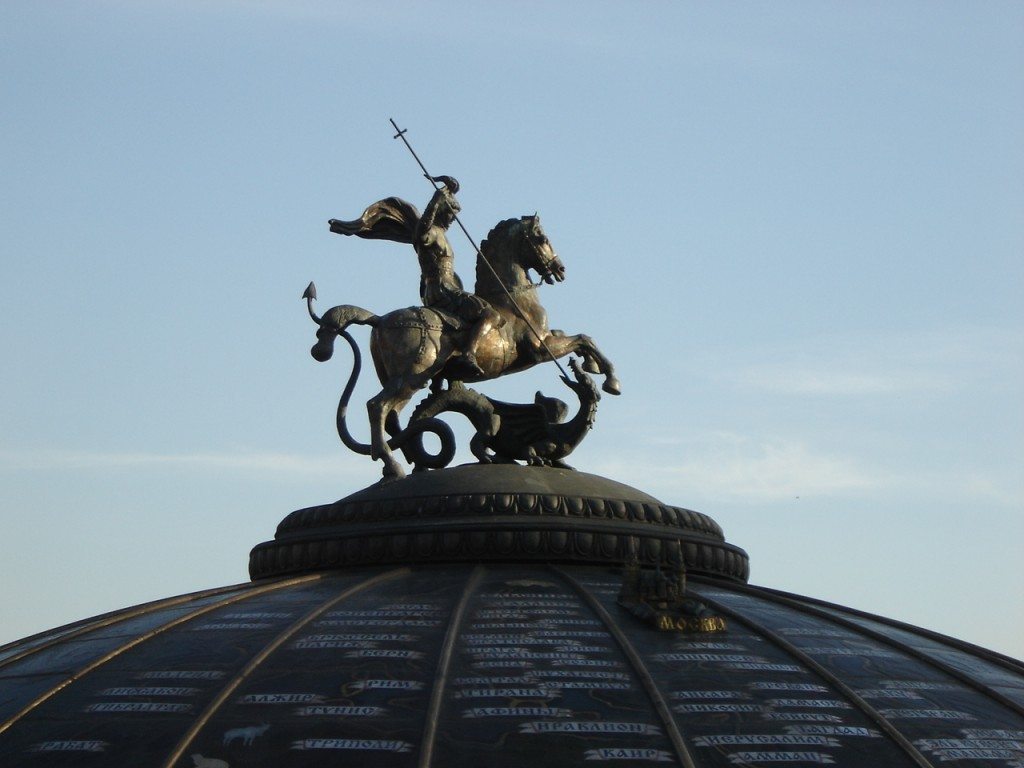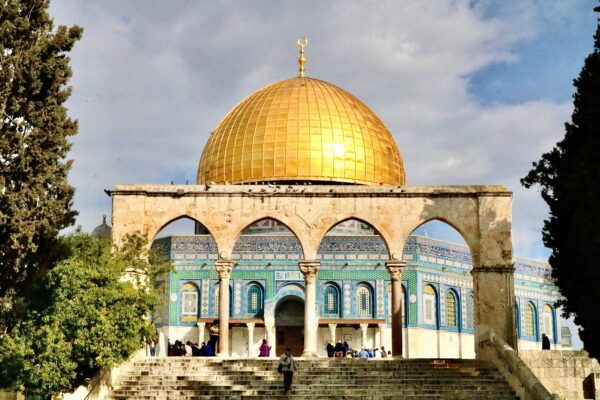“St George is a great symbol of courage, compassion and acceptance. If we could discuss the history and the context of when the man lived and how he is remembered and celebrated in so many diverse countries, he would be an invaluable asset to any community.”
“St George is a great symbol of courage, compassion and acceptance. If we could discuss the history and the context of when the man lived and how he is remembered and celebrated in so many diverse countries, he would be an invaluable asset to any community.”
[This article was originally published in April 2015 from Emel]
Saint of Agricultural workers, Aragon, archers, armourers, Boy Scouts, butchers, Canada, cavalry, chivalry, equestrians workers, farmers, Ferrara, Genoa, Georgia, Germany, horsemen, horses, field husbandmen, Istanbul, knights, lepers, lepers and leprosy, Lithuania, Moscow, the Order of the Garter, Palestine, Palestinian Christians, plague, Portugal, riders, saddle makers, skin diseases, soldiers and Venice.
Oh, and of course England.
It is one of those strange ironies that the patron Saint of England is half Turkish and half Palestinian. That he has become an emblem of the English nation despite his “foreign blood” is deeply symbolic given current debates on belonging. In this special feature on St. George, we look at what he means to people here and abroad, and why he is the perfect patron for Britain today.
 Many would argue that only the fuzzy demarcation lines of Britishness have allowed the four nations to be together. But is there a way to unite people that allows for our historic multiculturalism and yet has strength and integrity for the present and future? Sometimes looking at the history of our national emblems and symbols can give key insights into how we have imbued much from far away and made it our own – for example, the rose, the Christian faith and, of course, St George.
Many would argue that only the fuzzy demarcation lines of Britishness have allowed the four nations to be together. But is there a way to unite people that allows for our historic multiculturalism and yet has strength and integrity for the present and future? Sometimes looking at the history of our national emblems and symbols can give key insights into how we have imbued much from far away and made it our own – for example, the rose, the Christian faith and, of course, St George.
St George was born in Cappadocia, in modern-day Turkey to an army soldier and a mother from Lydda, now known as Lod in Palestine. After his father’s death, George’s mother took her infant son back to her hometown of Lydda where he grew up to serve as an officer in the Roman army, like his father before him. When ordered by a pagan ruler, the Emperor Diocletian, to pay tribute to Roman gods, he refused and faced prolonged periods of torture – in some stories as long as seven years, ending with a gruesome death: sliced in half and beheaded.
From this rather grisly end, he has become a hero and a national icon for many. From Canada to Moscow, Boy Scouts to saddle makers, Palestine to England, he is celebrated the world over. In England, he is celebrated on 23rd April. A day, like the man himself, borrowed from the East. In Turkey, the 23rd of April is called the Feast of Lydda, observed throughout Turkey as the beginning of spring.
Muslims regard him as dying in a state of submission to the One Creator.”
George’s death occurred around the fourth century AD, some 300 years before the last prophet of Islam completed the Message of God to His creation with the Qur’an. Thus as a true follower of monotheism, Muslims regard him as dying in a state of submission to the One Creator. Or in Arabic – of dying in a state of Islam.
As such, George has acquired status as a Muslim martyr. Muslims across the Middle East have traditionally associated George with Al Khidr, literally ‘the Green One’, signifying wisdom that is ever fresh and imperishable. Al Khidr is described in the Qur’an as a mystical boat companion of Moses, and even though Moses’ time was centuries earlier, the linking of George to this Qur’anic personality has held the imagination, and the similarity of title has meant the two figures have become entwined.
 According to tradition, George often prayed near the Temple Mount in Jerusalem where an elongated mosque named Qubbat Al-Khidr is dedicated to him. Located within the terraced site of the Dome of the Rock, George’s shrine in Palestine came to be a place of pilgrimage for Christians and Muslims seeking out its special healing powers. Women visited the site in hope of conceiving, while those with health complaints would go there for miraculous cures. Many other sites throughout the Islamic world resound with Al-Khidr, one of the most notable being the great Beirut mosque of Al-Khidr that lies close to where George legendarily slayed the dragon, saved a princess, and caused the whole city to convert to Christianity.
According to tradition, George often prayed near the Temple Mount in Jerusalem where an elongated mosque named Qubbat Al-Khidr is dedicated to him. Located within the terraced site of the Dome of the Rock, George’s shrine in Palestine came to be a place of pilgrimage for Christians and Muslims seeking out its special healing powers. Women visited the site in hope of conceiving, while those with health complaints would go there for miraculous cures. Many other sites throughout the Islamic world resound with Al-Khidr, one of the most notable being the great Beirut mosque of Al-Khidr that lies close to where George legendarily slayed the dragon, saved a princess, and caused the whole city to convert to Christianity.
One main reason for Muslims revering him over time is that he was martyred for refusing to give divine honours to idols.”
Anthony Cooney, the author of the books, The Story of St George and Saint George: Knight of Lydda, commented on George as a “man for all people”, not being confined to one country or a single cause. Cooney finds that George’s appeal to Muslims is not something that should be treated as strange. “St George is an ecumenical saint. He is not just for one nation; he is patron saint of many, making him pretty universal. One main reason for Muslims revering him over time is that he was martyred for refusing to give divine honours to idols, and as such is delivered up as a staunch monotheist.”
Many accounts have George destroying idols in the temple of Apollo, a story that resounds remarkably with the account of Abraham smashing the idols in his time. Although there are some voices of dissent regarding his martyrdom status, according to Cooney there is a “tremendous amount of evidence”, which can leave us in no doubt of the years of torture he endured and his subsequent death.
The spread of St George’s cult around the world in places such as Palestine, Syria, Egypt, Ethiopia, Istanbul, Greece, Germany, and Portugal to name a few, accounts for, in Cooney’s words, the ‘universality of the cult’. Thousands of narratives and images of St George have circulated throughout history and many lands, with references in Ibn Battuta’s travel journal and even modern-day allusions such as William Dalrymple’s, From the Holy Mountain. The cult of St George journeyed from the East to English shores before the 11th century, spreading from other European countries.
 It was strengthened in the 14th century when Edward III established a fraternity, choosing George as the patron saint of his ‘Order of the Garter’ as a spiritual focus for military endeavours during the 100 Years War against France.
It was strengthened in the 14th century when Edward III established a fraternity, choosing George as the patron saint of his ‘Order of the Garter’ as a spiritual focus for military endeavours during the 100 Years War against France.
George was also a great favourite of Henry VIII who issued a coin depicting George slaying the dragon, in the 16th century. There is evidence of the saint being in pageants in Dublin and Scotland, but his popularity was concentrated in the south and east of England through countless plays and pageants.
The patronage of St George has not always been used for such celebratory purposes. Armies in the Crusades killed tens of thousands under his banner. A Church in Devon has an image of him spearing Saracens. And in 1975, the League of St George was founded. It is an organisation hostile to immigrants and one that warned of the ‘threat’ posed to Britain’s national identity from immigration. The BNP use the flag of St George to champion their call for an England for the “English”. Little could be more ironic.
It is these associations with St George that detracts many Muslims in Britain from celebrating him. Sulaiman Choudhury, a City worker from Brighton recently came across a group of BNP protestors. “Loud music blared from megaphones, bolstered by angry chanting in a menacing manner. Unfortunately they were holding the red and white flag of St George. It is this connotation of the flag that comes to many people’s minds all too frequently. They have hijacked this symbol.”
He, though, is informed about St George’s parentage and can see the irony and believes St George is a potential role model. “St George is a great symbol of courage, compassion and acceptance. If we could discuss the history and the context of when the man lived and how he is remembered and celebrated in so many diverse countries, he would be an invaluable asset to any community.”
Others agree – Ahmed Thomson, a barrister and born on St. George’s day, says, “He was martyred in Palestine because he was a monotheist. It is clear therefore that any true follower of St. George should be opposed to the race and religious discrimination which certain members of the BNP so blatantly display.”
How and why a nation chooses its patron saint is often a strange matter, and even those who might not sign up to the full-blown celebrations on April 23rd still seem to admire St George. According to Daniel Baker, a furniture installer from Dagenham, George is a saint “not because of where he was from, but because of what he stood for and what he did when he was alive.”
Hannah Mummery, a policy and research manager from Kent concurs. “It is about the way we see ourselves as a nation and the values we want to uphold. When picking a patron in any walk of life we want to see them reflecting the values we aspire to and hold dear. I suppose St George does just this, whether you see the mythical dragon slayer who sacrificed himself to save the life of a beautiful woman or the humble Palestinian soldier who died defending his faith – both St Georges reflect an aspiration – selflessness, bravery, faith, courage and a commitment to what you believe to be right. All fine values for a nation to aspire to.”
Maybe the fine values of St George are what can bring us all together.”
Certainly, as a saint connected with healing, he can be taken as a symbol to heal the divide amongst communities. He can surely be looked to as an example of religious and racial pluralism. With his mixed ethnicity and his multiple identities, he encompasses many of today’s battle lines.
Maybe the dragon of arrogance, ignorance, and prejudice can be slayed under the banner of St George. And with his impeccable monotheistic credentials, Muslims shouldn’t hesitate in holding up his banner.





